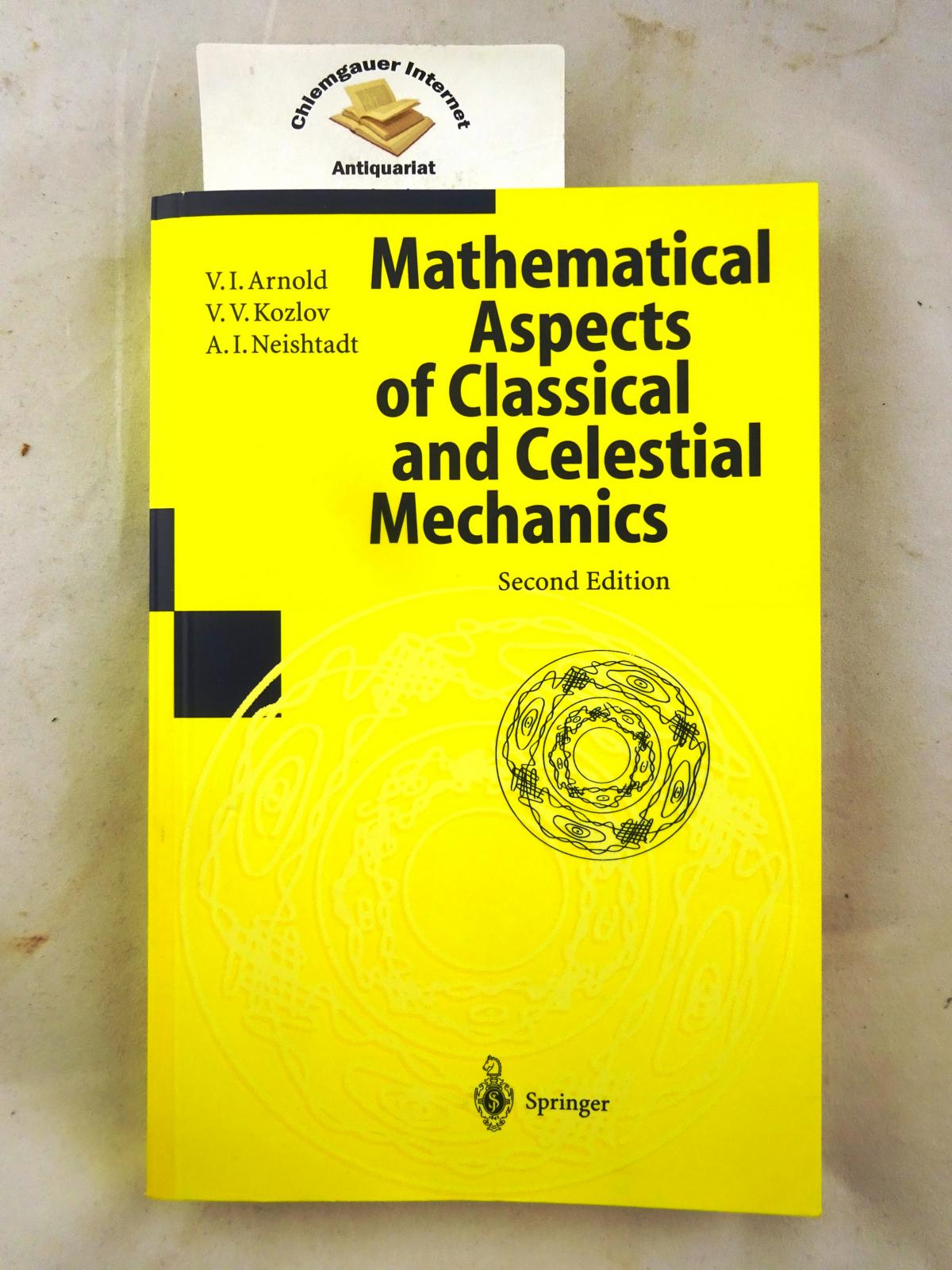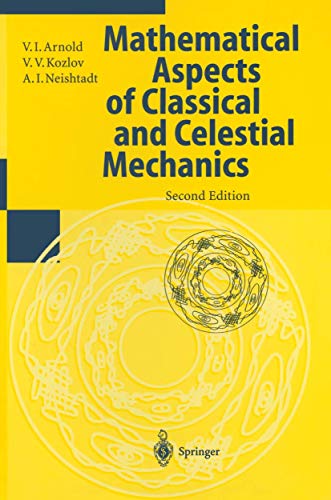
1997, ISBN: 3540612246
[EAN: 9783540612247], Gebraucht, wie neu, [SC: 3.95], [PU: Berlin ; Heidelberg ; Singapore ; Tokyo ; New York ; Barcelona ; Budapest ; Hong Kong ; London ; Milan ; Paris ; Santa Clara : S… Mehr…
| ZVAB.com Chiemgauer Internet Antiquariat GbR, Altenmarkt, BAY, Germany [51722192] [Rating: 5 (von 5)] NOT NEW BOOK. Versandkosten: EUR 3.95 Details... |

1997, ISBN: 3540612246
[EAN: 9783540612247], Gebraucht, wie neu, [PU: Berlin ; Heidelberg ; Singapore ; Tokyo ; New York ; Barcelona ; Budapest ; Hong Kong ; London ; Milan ; Paris ; Santa Clara : Springer], TH… Mehr…
| AbeBooks.de Chiemgauer Internet Antiquariat GbR, Altenmarkt, BAY, Germany [51722192] [Rating: 5 (von 5)] NOT NEW BOOK. Versandkosten: EUR 3.95 Details... |

1997, ISBN: 9783540612247
Second edition. XIV, 291 Seiten. 81 Abbildungen ; 24 cm Originalbroschur. FRISCHES, SEHR schönes Exemplar . In excellent shape. Versand D: 3,95 EUR Theoretische, klassische, Mechanik, Ph… Mehr…
| buchfreund.de Chiemgauer Internet Antiquariat GbR, 83352 Altenmarkt Versandkosten:Versandkosten innerhalb der BRD. (EUR 3.95) Details... |

1996, ISBN: 9783540612247
[PU: Springer Berlin], Gepflegter, sauberer Zustand. 2. Auflage. Aus der Auflösung einer renommierten Bibliothek. Kann Stempel beinhalten. 95451/202 Altersfreigabe FSK ab 0 Jahre, DE, [S… Mehr…
| booklooker.de |

1996, ISBN: 3540612246
[EAN: 9783540612247], Gebraucht, guter Zustand, [PU: Springer Berlin], Gepflegter, sauberer Zustand. 2. Auflage. Aus der Auflösung einer renommierten Bibliothek. Kann Stempel beinhalten. … Mehr…
| AbeBooks.de Buchpark, Trebbin, Germany [83435977] [Rating: 5 (von 5)] NOT NEW BOOK. Versandkosten:Versandkostenfrei. (EUR 0.00) Details... |


1997, ISBN: 3540612246
[EAN: 9783540612247], Gebraucht, wie neu, [SC: 3.95], [PU: Berlin ; Heidelberg ; Singapore ; Tokyo ; New York ; Barcelona ; Budapest ; Hong Kong ; London ; Milan ; Paris ; Santa Clara : S… Mehr…

Arnold, V. I., Valerij V. Kozlov and A.I. Neishtadt:
Mathematical aspects of classical and celestial mechanics. - Taschenbuch1997, ISBN: 3540612246
[EAN: 9783540612247], Gebraucht, wie neu, [PU: Berlin ; Heidelberg ; Singapore ; Tokyo ; New York ; Barcelona ; Budapest ; Hong Kong ; London ; Milan ; Paris ; Santa Clara : Springer], TH… Mehr…

1997
ISBN: 9783540612247
Second edition. XIV, 291 Seiten. 81 Abbildungen ; 24 cm Originalbroschur. FRISCHES, SEHR schönes Exemplar . In excellent shape. Versand D: 3,95 EUR Theoretische, klassische, Mechanik, Ph… Mehr…

1996, ISBN: 9783540612247
[PU: Springer Berlin], Gepflegter, sauberer Zustand. 2. Auflage. Aus der Auflösung einer renommierten Bibliothek. Kann Stempel beinhalten. 95451/202 Altersfreigabe FSK ab 0 Jahre, DE, [S… Mehr…

1996, ISBN: 3540612246
[EAN: 9783540612247], Gebraucht, guter Zustand, [PU: Springer Berlin], Gepflegter, sauberer Zustand. 2. Auflage. Aus der Auflösung einer renommierten Bibliothek. Kann Stempel beinhalten. … Mehr…
Bibliographische Daten des bestpassenden Buches
| Autor: | |
| Titel: | |
| ISBN-Nummer: |
Detailangaben zum Buch - Mathematical Aspects of Classical and Celestial Mechanics
EAN (ISBN-13): 9783540612247
ISBN (ISBN-10): 3540612246
Taschenbuch
Erscheinungsjahr: 1997
Herausgeber: Springer-Verlag Berlin and Heidelberg GmbH & Co. K
Buch in der Datenbank seit 2007-05-27T15:48:57+02:00 (Berlin)
Detailseite zuletzt geändert am 2024-05-28T17:13:30+02:00 (Berlin)
ISBN/EAN: 3540612246
ISBN - alternative Schreibweisen:
3-540-61224-6, 978-3-540-61224-7
Alternative Schreibweisen und verwandte Suchbegriffe:
Autor des Buches: arnol, arnold vladimir, kozlov
Titel des Buches: mathematical aspects classical and celestial mechanics, aspect
Daten vom Verlag:
Autor/in: V.I. Arnold; Victor V. Kozlov; A.I. Neishtadt
Titel: Mathematical Aspects of Classical and Celestial Mechanics
Verlag: Springer; Springer Berlin
294 Seiten
Erscheinungsjahr: 1996-12-18
Berlin; Heidelberg; DE
Gedruckt / Hergestellt in Deutschland.
Übersetzer/in: A. Iacob
Gewicht: 0,520 kg
Sprache: Englisch
85,55 € (DE)
87,95 € (AT)
106,60 CHF (CH)
Not available, publisher indicates OP
BC; Book; Hardcover, Softcover / Mathematik/Analysis; Mathematische Analysis, allgemein; A; Analysis; Mathematics and Statistics; Theoretical, Mathematical and Computational Physics; Mathematische Physik
1. Basic Principles of Classical Mechanics.- § 1. Newtonian Mechanics.- 1.1. Space, Time, Motion.- 1.2. The Newton-Laplace Principle of Determinacy.- 1.3. The Principle of Relativity.- 1.4. Basic Dynamical Quantities. Conservation Laws.- § 2. Lagrangian Mechanics.- 2.1. Preliminary Remarks.- 2.2. Variations and Extremals.- 2.3. Lagrange’s Equations.- 2.4. Poincare’s Equations.- 2.5. Constrained Motion.- § 3. Hamiltonian Mechanics.- 3.1. Symplectic Structures and Hamilton’s Equations.- 3.2. Generating Functions.- 3.3. Symplectic Structure of the Cotangent Bundle.- 3.4. The Problem of n Point Vortices.- 3.5. The Action Functional in Phase Space.- 3.6. Integral Invariants.- 3.7. Applications to the Dynamics of Ideal Fluids.- 3.8. Principle of Stationary Isoenergetic Action.- § 4. Vakonomic Mechanics.- 4.1. Lagrange’s Problem.- 4.2. Vakonomic Mechanics.- 4.3. The Principle of Determinacy.- 4.4. Hamilton’s Equations in Redundant Coordinates.- § 5. Hamiltonian Formalism with Constraints.- 5.1. Dirac’s Problem.- 5.2. Duality.- § 6. Realization of Constraints.- 6.1. Various Methods of Realizing Constraints.- 6.2. Holonomic Constraints.- 6.3. Anisotropic Friction.- 6.4. Adjoining Masses.- 6.5. Adjoining Masses and Anisotropic Friction.- 6.6. Small Masses.- 2. The ?-Body Problem.- § 1. The Two-Body Problem.- 1.1. Orbits.- 1.2. Anomalies.- 1.3. Collisions and Regularization.- 1.4. Geometry of the Kepler Problem.- § 2. Collisions and Regularization.- 2.1. Necessary Conditions for Stability.- 2.2. Simultaneous Collisions.- 2.3. Binary Collisions.- 2.4. Singularities of Solutions in the ?-Body Problem.- § 3. Particular Solutions.- 3.1. Central Configurations.- 3.2. Homographic Solutions.- 3.3. The Amended Potential and Relative Equilibria.- § 4. Final Motions in the Three-Body Problem.- 4.1. Classification of Final Motions According to Chazy.- 4.2. Symmetry of Past and Future.- § 5. The Restricted Three-Body Problem.- 5.1. Equations of Motion. The Jacobi Integral.- 5.2. Relative Equilibria and the Hill Region.- 5.3. Hill’s Problem.- § 6. Ergodic Theorems in Celestial Mechanics.- 6.1. Stability in the Sense of Poisson.- 6.2. Probability of Capture.- 3. Symmetry Groups and Reduction (Lowering the Order).- § 1. Symmetries and Linear First Integrals.- 1.1. E. Noether’s Theorem.- 1.2. Symmetries in Nonholonomic Mechanics.- 1.3. Symmetries in Vakonomic Mechanics.- 1.4. Symmetries in Hamiltonian Mechanics.- § 2. Reduction of Systems with Symmetry.- 2.1. Lowering the Order (the Lagrangian Aspect).- 2.2. Lowering the Order (the Hamiltonian Aspect).- 2.3. Examples: Free Motion of a Rigid Body and the Three-Body Problem.- § 3. Relative Equilibria and Bifurcations of Invariant Manifolds.- 3.1. Relative Equilibria and the Amended Potential.- 3.2. Invariant Manifolds, Regions of Possible Motions, and Bifurcation Sets.- 3.3. The Bifurcation Set in the Planar Three-Body Problem.- 3.4. Bifurcation Sets and Invariant Manifolds in the Motion of a Heavy Rigid Body with a Fixed Point.- 4. Integrable Systems and Integration Methods.- § 1. Brief Survey of Various Approaches to the Integrability of Hamiltonian Systems.- 1.1. Quadratures.- 1.2. Complete Integrability.- 1.3. Normal Forms.- § 2. Completely Integrable Systems.- 2.1. Action-Angle Variables.- 2.2. Noncommutative Sets of First Integrals.- 2.3. Examples of Completely Integrable Systems.- §3. Some Methods of Integrating Hamiltonian Systems.- 3.1. Method of Separation of Variables.- 3.2. Method of L-A (Lax) Pairs.- §4. Nonholonomic Integrable Systems.- 4.1. Differential Equations with Invariant Measure.- 4.2. Some Solved Problems of Nonholonomic Mechanics.- 5. Perturbation Theory for Integrable Systems.- §1. Averaging of Perturbations.- 1.1. The Averaging Principle.- 1.2. Procedure for Eliminating Fast Variables in the Absence of Resonances.- 1.3. Procedure for Eliminating Fast Variables in the Presence of Resonances.- 1.4. Averaging in Single-Frequency Systems.- 1.5. Averaging in Systems with Constant Frequencies.- 1.6. Averaging in Nonresonant Domains.- 1.7. The Effect of a Single Resonance.- 1.8. Averaging in Two-Frequency Systems.- 1.9. Averaging in Multi-Frequency Systems.- §2. Averaging in Hamiltonian Systems.- 2.1. Application of the Averaging Principle.- 2.2. Procedures for Eliminating Fast Variables.- §3. The KAM Theory.- 3.1. Unperturbed Motion. Nondegeneracy Conditions.- 3.2. Invariant Tori of the Perturbed System.- 3.3. Systems with Two Degrees of Freedom.- 3.4. Diffusion of Slow Variables in Higher-Dimensional Systems, and its Exponential Estimate.- 3.5. Variants of the Theorem on Invariant Tori.- 3.6. A Variational Principle for Invariant Tori. Cantori.- 3.7. Applications of the KAM Theory.- § 4. Adiabatic Invariants.- 4.1. Adiabatic Invariance of the Action Variable in Single-Frequency Systems.- 4.2. Adiabatic Invariants of Multi-Frequency Hamiltonian Systems.- 4.3. Procedure for Eliminating Fast Variables. Conservation Time of Adiabatic Invariants.- 4.4. Accuracy of the Conservation of Adiabatic Invariants.- 4.5. Perpetual Conservation of Adiabatic Invariants.- 6. Nonintegrable Systems.- §1. Near-Integrable Hamiltonian Systems.- 1.1. Poincare’s Methods.- 1.2. Creation of Isolated Periodic Solutions is an Obstruction to Integrability.- 1.3. Applications of Poincare’s Method.- § 2. Splitting of Asymptotic Surfaces.- 2.1. Conditions for Splitting.- 2.2. Splitting of Asymptotic Surfaces is an Obstruction to Integrability.- 2.3. Applications.- § 3. Quasi-Random Oscillations.- 3.1. The Poincare Map.- 3.2. Symbolic Dynamics.- 3.3. Nonexistence of Analytic First Integrals.- § 4. Nonintegrability in the Neighborhood of an Equilibrium Position (Siegel’s Method).- § 5. Branching of Solutions and Nonexistence of Single-Valued First Integrals.- 5.1. Branching of Solutions is an Obstruction to Integrability.- 5.2. Monodromy Groups of Hamiltonian Systems with Single-Valued First Integrals.- § 6. Topological and Geometrical Obstructions to Complete Integrability of Natural Systems with Two Degrees of Freedom.- 6.1. Topology of the Configuration Space of Integrable Systems.- 6.2. Geometrical Obstructions to Integrability.- 7. Theory of Small Oscillations.- §1. Linearization.- § 2. Normal Forms of Linear Oscillations.- 2.1. Normal Form of Linear Natural Lagrangian Systems.- 2.2. The Rayleigh-Fischer-Courant Theorems on the Behavior of Characteristic Frequencies under an Increase in Rigidity and under Imposition of Constraints.- 2.3. Normal Forms of Quadratic Hamiltonians.- § 3. Normal Forms of Hamiltonian Systems Near Equilibria.- 3.1. Reduction to Normal Form.- 3.2. Phase Portraits of Systems with Two Degrees of Freedom in the Neighborhood of an Equilibrium Position under Resonance.- 3.3. Stability of Equilibria in Systems with Two Degrees of Freedom under Resonance.- § 4. Normal Forms of Hamiltonian Systems Near Closed Trajectories.- 4.1. Reduction to the Equilibrium of a System with Periodic Coefficients.- 4.2. Reduction of Systems with Periodic Coefficients to Normal Form.- 4.3. Phase Portraits of Systems with two Degrees of Freedom Near a Closed Trajectory under Resonance.- § 5. Stability of Equilibria in Conservative Fields.- Comments on the Bibliography.- Recommended Reading.This work describes the fundamental principles, problems, and methods of classical mechanics. The approach of the authors stresses the working apparatus of classical mechanics, rather than its physical foundations or applications. The main purpose of the book is to acquaint the reader with classical mechanics as a whole, in both its classical and its contemporary aspects.
Weitere, andere Bücher, die diesem Buch sehr ähnlich sein könnten:
Neuestes ähnliches Buch:
8601415653618 Mathematical Aspects of Classical and Celestial Mechanics (Encyclopaedia of Mathematical Sciences): Written by Vladimir I. Arnold, 2006 Edition, (3rd Edition) Publisher: Springer [Hardcover] (Arnold, Vladimir I.)
- 8601415653618 Mathematical Aspects of Classical and Celestial Mechanics (Encyclopaedia of Mathematical Sciences): Written by Vladimir I. Arnold, 2006 Edition, (3rd Edition) Publisher: Springer [Hardcover] (Arnold, Vladimir I.)
- 9783540282464 Mathematical Aspects of Classical and Celestial Mechanics: Third Edition (Encyclopaedia of Mathematical Sciences, 3, Band 3) (Arnold, Vladimir I. Kozlov, Valery V. Neishtadt, Anatoly I.)
- 9780387572413 Dynamical Systems III (Encyclopaedia of Mathematical Sciences) (Unknown)
- 9780387170008 Dynamical Systems I (ENCYCLOPAEDIA OF MATHEMATICAL SCIENCES) (Anosov, D. V. Aranson, Samuel Kh, Arnold, V. I. Bronshtejn, I. U. Grines, V. Z.)
- 9780387170022 Dynamical systems (Encyclopaedia of mathematical sciences) (Vladimir I. Arnold)
- 9780387181738 Dynamical Systems V: Bifurcation Theory and Catastrophe Theory (Encyclopaedia of Mathematical Sciences) (Arnol'd, Vladimir I.)
- Mathematical Aspects of Classical and Celestial Mechanics. Second Edition. (Arnold, V I, V V Kozlov and A I Neishtadt)
- Mathematical Aspects of Classical and Celestial Mechanics (Encyclopaedia of Mathematical Sciences) by Vladimir I. Arnold (2006-11-14) (Vladimir I. Arnold; Valery V. Kozlov; Anatoly I. Neishtadt)
< zum Archiv...



